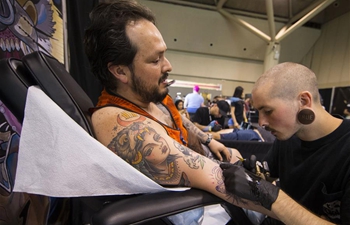WASHINGTON, June 11 (Xinhua) -- An international team of researchers have developed a refillable, implantable device, which can sit directly on the heart and deliver drugs and other therapies to treat the aftereffects of a heart attack.
According to a study published on Monday in the journal Nature Biomedical Engineering, a small patch called Therepi, which can be sutured onto the heart, contains a sponge-like "reservoir" that attaches directly to the damaged heart tissue.
A refill line connects the reservoir to a port on or under the patient's skin where therapies can be injected either by the patient or a healthcare professional.
The reservoir is constructed out of a gelatin-based polymer, with a half-spherical shape and a flat bottom, according to the study.
The flat bottom consists of a semi-permeable membrane that can be adjusted to allow more drugs or larger materials to pass directly into the heart tissue.
The reservoir can be used to administer stem cell therapies, acting as a cell factory. Rather than pass through the membrane into the heart, the stem cells stay within the reservoir where they produce paracrine factors that promote healing in the damaged heart tissue.
After a patient has a heart attack, a cascade of events leading to heart failure begins. Different therapies, including drugs, proteins and stem cells, could treat scarring but these treatments struggle to reach or stay at their intended target, according to the researchers from multiple organizations including Harvard University, Massachusetts Institute of Technology (MIT) and Royal College of Surgeons in Ireland.
"After a heart attack we could use this device to deliver therapy to prevent a patient from getting heart failure," said Ellen Roche, co-first author of the study and assistant professor at MIT's Department of Mechanical Engineering. "If the patient already has some degree of heart failure, we can use the device to attenuate the progression."
Therepi can administer localized, non-invasive therapies as many times as needed. The device's reservoir can be implanted on the heart in just one surgical procedure.
In a rat model, the device was shown to be effective in improving cardiac function after a heart attack.
The researchers administered multiple doses of cells to a damaged heart throughout a four-week period.
"We saw that the groups that had our device had recovered some heart function," said Claudia Varela, a PhD student in the Harvard-MIT Division of Health Sciences and Technology.
The hearts that received multiple dosages of cells via therapy had more cardiac function than those who received only a single injection or no treatment at all.
While the team has been focusing on how Therepi can mitigate the effects of heart disease, the device could be used in other parts of the body.













